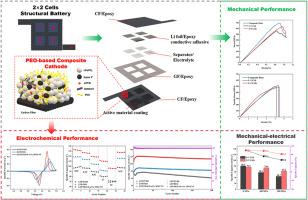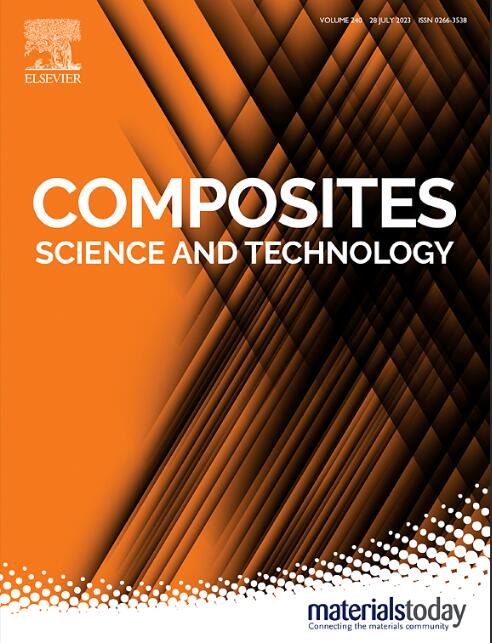Interface reinforced by polymer binder for expandable carbon fiber structural lithium-ion battery composites
IF 8.3
1区 材料科学
Q1 MATERIALS SCIENCE, COMPOSITES
引用次数: 0
Abstract
Carbon fiber (CF) composite structural battery (SB) is a novel energy storage device that integrates electrochemical energy storage with mechanical load-bearing capability. Carbon fiber's inherent conjugated carbon network possesses excellent electronic conductivity, thus serving as a current collector for electrode active materials. The bonding between active materials and carbon fibers relies on their manufacturing processes, requiring optimization of their electrochemical performance and addressing the challenges of large-scale production. In this work, a LiFePO4/PEO-LiTFSI/CF composite cathode was fabricated using the direct coating method. Polyethylene oxide (PEO) acted as a binder to form a stable LiFePO4 (LFP) coating on the carbon fiber woven fabric, while multi-walled carbon nanotube (MWCNT) were employed to construct a conductive network. This significantly enhanced both the charge-discharge performance and interface stability of the composite cathode. This composite cathode achieved a first-cycle discharge-specific capacity of 133.21 mAh·g−1 at 0.1 C rate and retained 93.7 % of its capacity after 200 cycles at 1 C rate. Based on this composite cathode, multiple active material coatings were integrated onto a carbon fiber woven fabric to manufacture an expandable multi-cell structural battery. Its advantage lies in the ability of multiple battery cells to disperse stress under load, thus achieving a higher capacity retention rate under bending loads. The structural battery possesses a high degree of customizability, allowing for adjustment of the area, position, and quantity of active material coatings to meet the demands of practical conditions.

用聚合物粘合剂增强可膨胀碳纤维结构锂离子电池复合材料的界面
碳纤维(CF)复合结构电池(SB)是一种集电化学储能和机械承载能力于一体的新型储能装置。碳纤维固有的共轭碳网络具有优异的电子导电性,因此可作为电极活性材料的集流器。活性材料与碳纤维之间的结合依赖于其制造工艺,需要优化其电化学性能并解决大规模生产所面临的挑战。在这项工作中,采用直接涂层法制造了 LiFePO4/PEO-LiTFSI/CF 复合阴极。聚氧化乙烯(PEO)作为粘合剂在碳纤维编织物上形成稳定的磷酸铁锂(LFP)涂层,而多壁碳纳米管(MWCNT)则用于构建导电网络。这大大提高了复合阴极的充放电性能和界面稳定性。这种复合阴极在 0.1 摄氏度条件下的第一周期放电特定容量为 133.21 mAh-g-1,在 1 摄氏度条件下循环 200 次后,容量保持率为 93.7%。在这种复合阴极的基础上,将多种活性材料涂层集成到碳纤维编织物上,制造出了一种可扩展的多芯结构电池。其优势在于多个电池单元能够分散负载下的应力,从而在弯曲负载下实现更高的容量保持率。这种结构电池具有高度的定制性,可根据实际情况调整活性材料涂层的面积、位置和数量。
本文章由计算机程序翻译,如有差异,请以英文原文为准。
求助全文
约1分钟内获得全文
求助全文
来源期刊

Composites Science and Technology
工程技术-材料科学:复合
CiteScore
16.20
自引率
9.90%
发文量
611
审稿时长
33 days
期刊介绍:
Composites Science and Technology publishes refereed original articles on the fundamental and applied science of engineering composites. The focus of this journal is on polymeric matrix composites with reinforcements/fillers ranging from nano- to macro-scale. CSTE encourages manuscripts reporting unique, innovative contributions to the physics, chemistry, materials science and applied mechanics aspects of advanced composites.
Besides traditional fiber reinforced composites, novel composites with significant potential for engineering applications are encouraged.
 求助内容:
求助内容: 应助结果提醒方式:
应助结果提醒方式:


